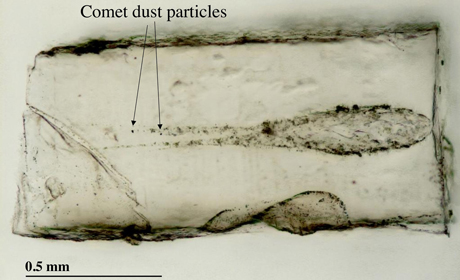On the Origins of Our Solar System
31 January 2012
After positive evaluation by an international team of experts, the Priority Programme (SPP 1385) “The First Ten Million Years of the Solar System” supported by the German Research Foundation (DFG) has now embarked on its second funding period with twelve new projects on board. The programme is coordinated by Prof. Dr. Mario Trieloff of Heidelberg University and Prof. Dr. Klaus Mezger of the University of Bern (Switzerland) and at present comprises 45 research projects, ten of them in Heidelberg. The aim of the scientists involved in SPP 1385 is to analyse extraterrestrial material such as meteorites for what it can tell them about the planet formation process taking place 4.5 billion years ago. The DFG is providing approx. EUR 5.5 million for the continuation of the research work, of which EUR 1.2 million has been allocated to Heidelberg.

Source: NASA
The goal of the projects in the first funding period was to deepen our understanding of the way planets form. “Planets are the very basis of life as we know it,” says earth scientist Mario Trieloff. “But the formation process involved is still surrounded by many mysteries. For example, from meteorites we are familiar with the first centimetre-sized mineral aggregates in the solar system, but we know very little about how they formed.” In the course of time, dust particles mere micrometres in diameter clump together to form “whoppers” several metres in diameter or even asteroids and comets that can be kilometres in size. But we still do not know whether the time scale involved in their formation was thousands or millions of years. Also unanswered is the question of how the Earth formed out of a number of smaller protoplanets or where the water on Earth came from. According to Prof. Trieloff, major progress towards the solution of these issues has already been made in the first funding period.
The investigations of the priority programme revolve crucially around material from small bodies like asteroids and comets, the point being that they have not evolved to the formation of a large planet but have remained at the level of small planets called planetesimals. “This means that they have preserved the unchanged relics of dust and rock composition on the way to larger planetary bodies,” says Prof. Trieloff. In this connection, the scientists are investigating sample material from meteorites and comets as well as interstellar material from which the first small bodies and planetesimals took shape. Isotopic dating is used to define more closely the span of time in which asteroids hundred of kilometres across achieved their present dimensions. In addition, the scientists are looking into the heating and the chemical and physical development of planetesimals.
For the first two years of the research work being done in the framework of SPP 1385, 36 projects with a funding volume of approx. EUR 4 million were approved. Of these, 33 are to be continued and supplemented by the 12 new projects. According to coordinators Mario Trieloff and Klaus Mezger, the international evaluation panel ranked the priority programme as being on the same level as the thematically similar cosmochemistry programme of NASA. In their evaluation report, they anticipated that the large proportion of young scientists involved would contribute to the development of new approaches that might be pioneering in the international context. The ten Heidelberg projects are conducted at the University’s Institute for Earth Sciences, Centre for Astronomy and Kirchhoff Institute for Physics and the Max Planck Institutes for Astronomy and for Nuclear Physics. The research projects of the entire programme are spread out over 16 locations in Germany plus the Institute of Geological Sciences at the University of Bern.
For more information, go to www.rzuser.uni-heidelberg.de/~ia2.
Note for newsdesks:
Picture material is available from the Press Office.
Contact:
Apl. Prof. Dr. Mario Trieloff
Institute for Earth Sciences, phone +49 6221 54-6022
mario.trieloff@geow.uni-heidelberg.de
Communications and Marketing
Press Office, Phone +49 06221 54-2311
presse@rektorat.uni-heidelberg.de

